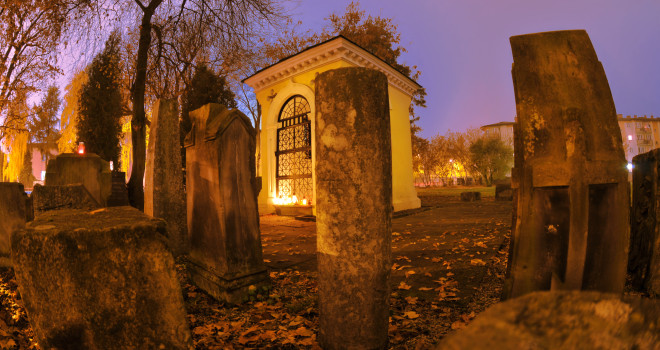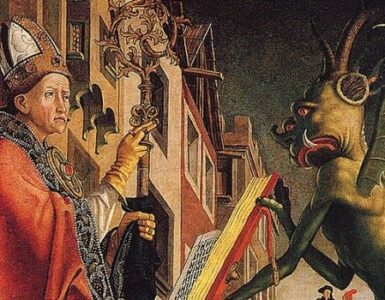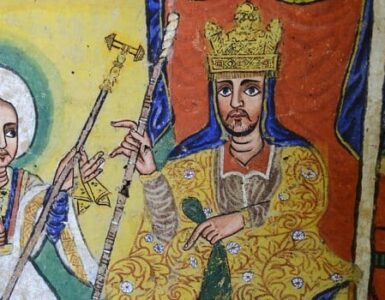
 Halloween is often identified as unhallowed. Witchcraft. Druidism. The occult. Evils all, no doubt, yet no matter what evils have invaded or informed Halloween, its traditions find their essential origin in mankind’s inherent awareness of beings, powers, and even worlds beyond his own—which is the opposite of an evil instinct. That the universe holds more than meets the eye, or more than the mind can conceive, was evident even to pagans; but what that “more” actually consisted of was not as evident as it was to become. Halloween stands as a testimony to man’s innate hunger for the holy, and a remnant of a time that still has a part to play in the pageantry of human redemption.
Halloween is often identified as unhallowed. Witchcraft. Druidism. The occult. Evils all, no doubt, yet no matter what evils have invaded or informed Halloween, its traditions find their essential origin in mankind’s inherent awareness of beings, powers, and even worlds beyond his own—which is the opposite of an evil instinct. That the universe holds more than meets the eye, or more than the mind can conceive, was evident even to pagans; but what that “more” actually consisted of was not as evident as it was to become. Halloween stands as a testimony to man’s innate hunger for the holy, and a remnant of a time that still has a part to play in the pageantry of human redemption.
Pre-Christian history and folklore abound with concepts, expressions, and depictions that manifestly indicate the conviction and the consequent pursuit of super-realities. The pagan sensed that he belonged to two worlds, the material and the immaterial, for he was himself body and soul. Although this spiritual world was largely hidden, he, as a member of that spiritual world, was not satisfied with life isolated from beings greater than he. From this arose a thirst to know the ultimate and immortal realities of life. So man did what must be called the human prerogative: he imagined them. Man conjured up a host of otherworldly existences to provide a context whereby he might judge things beyond his ken.
These numinous musings provided the backbone to mythologies, homespun rituals, and rustic legends. Such time-trusted tales reveal an undeniable fervor in their quest, seeking for answers to cosmic questions arising from the primal and mystical sensitivity of the human spirit. What are the secrets behind the inscrutable mysteries of nature? What is the purpose of life? What occurs after death? What are the truths surrounding unexplained phenomena that people suddenly witness? The creations of lore became archetypes which men—with fearful desire—believed in as they groped in dark and unenlightened days for a truth that would satisfy their yearning souls.
As the seasonal light of day gave way to darkness, and nature shed its splendor and beauty to don decay and seeming death, man’s mind turned to the end of his own life and to those who had gone before him. The afterlife and the supernatural mingled with the fear of the unknown. During autumn, when the world seems to suffer a sort of death in aspects both wondrous and withering, men would spy strange shapes across the moon and women would tell strange stories over the fire. The devils, preying upon ignorance and terror, would weave their lies within the noble aspirations of man, even binding some to their service through hollow rituals. Nevertheless, lively celebrations were born that declared a demand to know more about the world beyond sight.
With the coming of Christ came the answers the world sought. Man belongs to both worlds because he was made in the image and likeness of God. By that image he was to grasp and partake in the spiritual world of God, and by that divine image to rule this world and discover her secrets. Sadly, that image was darkened by sin, which prevented man from seeing the truth with clarity. But Christ, the Invisible made visible, healed and restored the divine image within humanity. In His life He revealed great and wondrous things. In His death and resurrection, the ancient enemy, the devil, was subjugated and death stripped of his sting. Every seemingly unfulfillable longing was satisfied in abundance. Man was finally granted a genuine taste of goodness, truth, and beauty in this world, and the hope of beholding their perfection in the next.
In the light of Christ, ancient folklore and customs, both the insidious and innocuous, moved from the realm of religion to myth. Some were destined to remain, though, purified as memorials to the nobility of pagan forefathers or as testimonials to the dignity and credibility of Christianity. The ghostly ceremonies that Halloween mirrors were inserted into custom as expressive of a vital stage in the para-liturgical re-enactment of salvation history. After the feast of Pentecost, the faithful enter into the age of the Church on earth. Emboldened by the Holy Spirit, the Church moves through time towards the consummation of all things, when all will be gathered and subjected to Christ.
As the liturgical year ends its course, minds turn to this end and the Church presents the feast of Christ the King, King of heaven and earth. Fittingly, the Church has arranged her calendar so that these mysteries unfold before her faithful within the earthly period of harvest, the annual time of gathering. Following the celebration of Christ the King comes the festival of Halloween, and the feasts of All Saints and All Souls. It is in this sequence that Christians include Halloween in the drama of redemption. Halloween offers the proper point for the beginning of the Church Militant’s liturgical observance of the faithful departed, for it represents man’s profound hope for the joys of eternal blessedness after death. In these observances, man is given a foretaste of his own destiny: death, judgment before the King and Judge, and then, by God’s grace, the blessedness of the saints, having been purified by love.
Halloween’s deathly themes present the natural place to begin this ceremony because death precedes the glory of the saints and the redemptive suffering of purgatory. Halloween is the dramatic and jocular representation of this death, as a portal to new life. Moreover, in humanity’s present condition, the power and peace of grace is often known only in contrast to evil; and conversely the horror of evil is easily grasped in light of the good, true, and beautiful. By these comparisons, people are reminded of the great darkness of error and the intense longing of mankind for Christ.
Catholics should begin the season of souls with this merry Day of the Dead because it expresses the first consequent of Christ’s death and resurrection. Death is an empty thing since the dominion of the devil has been destroyed—and that is something worthy of celebration. The glory of the resurrection, the glory of the saints, comes forth from death and the conquered the power of sin. Christ has given man victory by His grace and mastery over demonic and deathly sway. Halloween rejoices in this triumph through playful parody, or exultant mockery, of evil by subjecting the powerless symbols of the devil to satirical derision. Witches, goblins, ghosts, skeletons, and the other grotesque objects of man’s imagination are the caricatures of a dethroned evil. There is no fear in these, or even in the devil himself, by the indomitable strength of Christ. Men are the masters, and no longer the servants, of these elemental creatures.
In spite of the shadows, the tales and rituals surrounding Halloween chronicle man’s understanding of himself, death, and the condition of the soul after death. Though error and the demoniac have affected the imagination, Halloween highlights man’s keen instinct and healthy curiosity towards the spirit of things. The traditions of god, ghost, and goblin are historically rooted in a healthy, human, and even holy mentality rather than a heathen one, and one that Halloween can still uphold today by the light of the Holy Spirit.
image: A Polish cemetery adorned with candles for All Saints Day / Shutterstock










